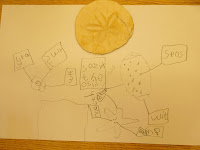
So many apps, so little time! I have had several requests to find
out what apps we are using in class. I've also heard the children saying that many of you have already downloaded some of the apps we have done in class. That is so great! I love to share! There are
bunches and bunches of educational apps. Here a few of our
class's favorites. As we add more in class, I will continue
highlighting student and teacher favorites.
Letter School-
This is an incredible handwriting and phonics app. It helps children
with correct letter formation and letter/sound association. $4.99
Starfall- In this app, students see, hear, interact, and play with letters and sounds. $2.99
Letter of the Day-
This app, again, works on letter and sound identification and
association. The game provides instant feedback and helpful hints.
$1.99
Sound Sorting- Here is an interactive game that let's children sort pictures by beginning sound. $0.99
Sight Words PhotoTouch-
The ipad says a sight word and the kids have to touch the correct word
out of 4 different choices. The same app is also available for just
letter identification. Free.
Reading Rainbow-
(with subscription) This is an amazing resource. With this app,
children have access to an incredible library of wonderful literature.
Children can read the books themselves or get the books read to them.
Further, the app has short video clips that compliment the stories. How
do children become better readers? They read, read, read! This app is
packed with reading opportunities and probably my all time favorite.
Scribble Press-
I have this app on the students' dock because we use it all the time.
This app allows the children to write and illustrate books then has an
option to share/ publish their creations into ibooks. $2.99
Teach Me First Grade- This
app has several games that cover and practice important first grade
skills, both math and reading. Plus, the app tracks progress and has an parent screen where
you can monitor your child's progress. This app also has a kindergarten and
second grade version. $1.99
On our math page, we also have several awesome apps. Here are just a few for now.
Quick Images-
This app is spectacular for developing number sense and mathematical
strategies. See the post below for more specifics. I highly recommend
this app. $0.99
Counting Board- A great app to practice counting and identifying the numbers to 100. Free.
123 Number Magic- An app to practice counting and number identification. Free.
PrestoBingo Shapes- This app explores geometry. Students have to find shapes hidden in pictures. $1.99
Sid's Science Fair- Here is a science app that really engages the kids. $2.99
Math Tappers- Find Sums- This app builds a foundation for addition and develops early addition skills.
This
is certainly not everything, but a good start. Like I said, I will
continue to update as we introduce new apps in class or as I discover
new apps. You will notice at the top button bar of the blog there are links to Reading Apps and Math Apps. Here you can see apps we will use through out the year. If you click on the icons for the app, it will take you to the itunes store and more information about the app. I appreciate your interest and support!





















































